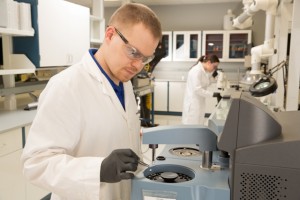
A firefighter runs into a burning building to save people trapped inside. A co-worker bails from the meeting where your team will be discussing a tense business situation. You can tell a lot about people by how they behave when the heat is on. The same is true of polymers.
When we use differential scanning calorimetry (DSC) to analyze a polymer sample, we can learn a great deal about the nature of that polymer and how it might perform in a real-world application. Simply stated, DSC testing involves heating two pans — one empty reference pan and one containing a polymer sample — and measuring the difference in the amount of energy needed to increase the temperature of both pans at the same rate. Hint: the polymer pan will require more energy to heat up!
DSC testing allows us to identify the temperatures at which the sample undergoes types of transitions that are specific to polymers. Remember, polymers are long chains of molecules and at different stages (and temperatures) those molecules behave in varying ways. Heat (which is really just the energy released by molecules that are moving around a lot) propels those transitions in a polymer.
By heating a sample through DSC, we can identify a polymer’s:
- Glass transition temperature — A transition that’s unique to polymers, the glass transition temperature is the temperature at which a polymer becomes hard and brittle, like glass.
- Heat capacity — This is the amount of heat required to accomplish a certain temperature increase in a material.
- Crystallization point — This is the temperature at which the molecules in a polymer line up (or mostly line up) into tidy chains and/or stacks of chains.
- Melting point — When a polymer reaches its melting point, the molecule chains will slide out of order, move around freely and the polymer undergoes a significant change in its appearance and behavior
- Enthalpy – This is the amount of energy absorbed or released by the sample as it goes through a melt (enthalpic heat of fusion) or crystallization (enthalpic heat of crystallization).
All of this heat-related data can help people understand the performance characteristics of their materials. This is critical since certain polymers, like polyisoprene, are typically used above their glass transition temperatures, and others, such as polystyrene, are used below it. For example, if your goal is to create a type of flexible tubing to be used in a vehicle engine, it’s important to know the glass transition temperature and melting point of the polymer you’re using. Likewise, no one wants a snow shovel made out of a plastic that will be so brittle out in the cold that it shatters if it hits some ice.
DSC testing provides us with a wealth of information since it helps us understand the thermal transitions that occur within a sample, including residual activity, evaporation of solvents, melting, cystallization, crystal transitions and glass transition temperatures. At Polymer Solutions Inc., our team has employed DSC testing on a number of products, such as injection-molded plastic, medical devices and melt spun-fiber products.
When it comes to predicting which co-worker will stick around for that high-pressure meeting, you’re on your own! If you need to know how your polymer will behave when the heat is on reach out to us about DSC testing.
